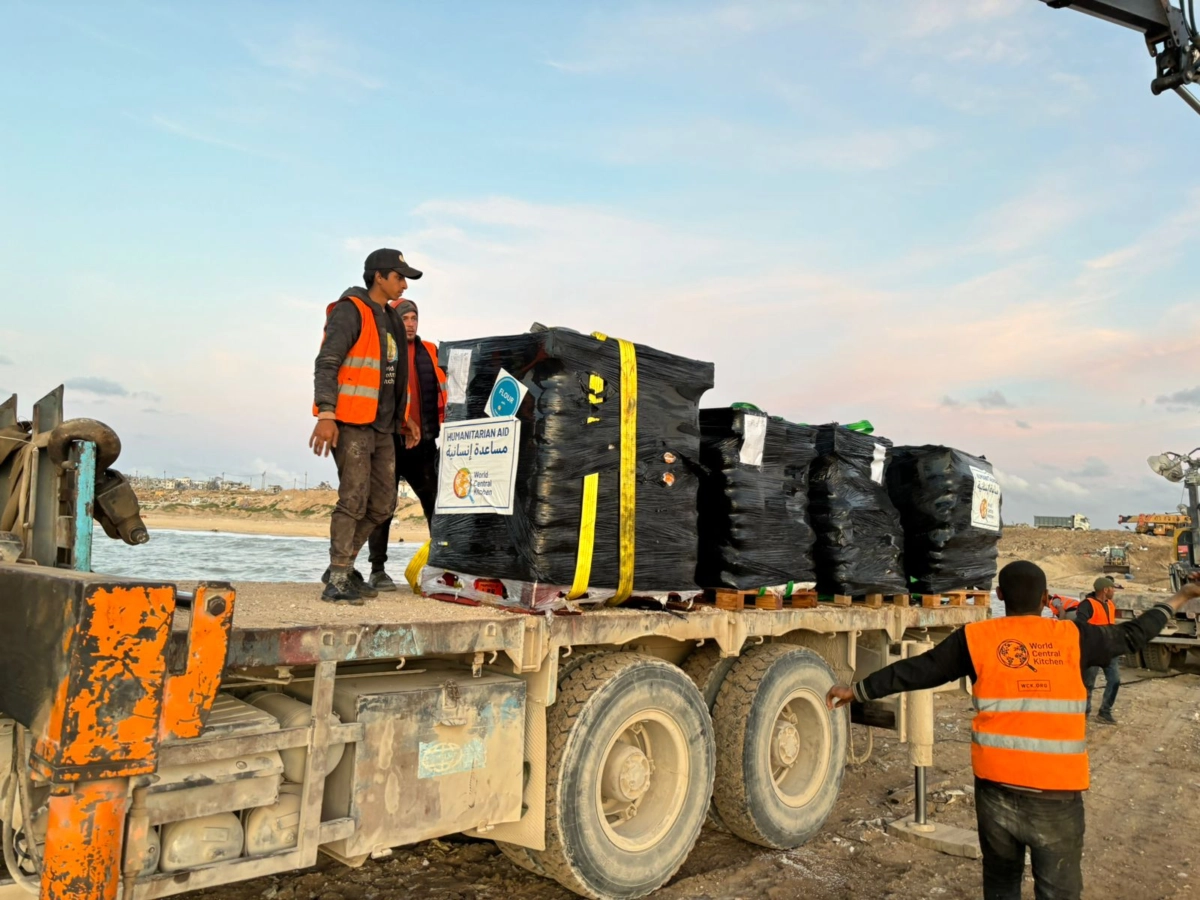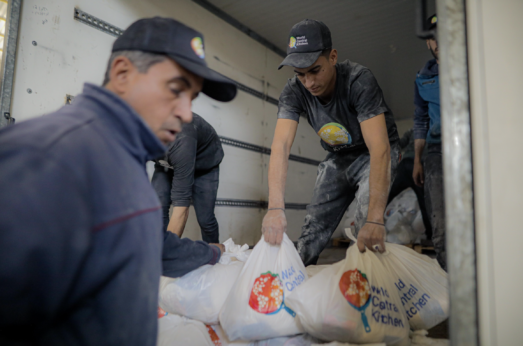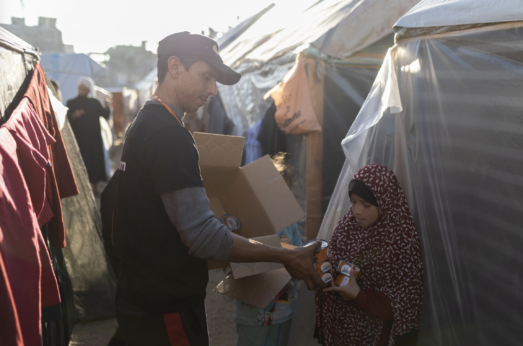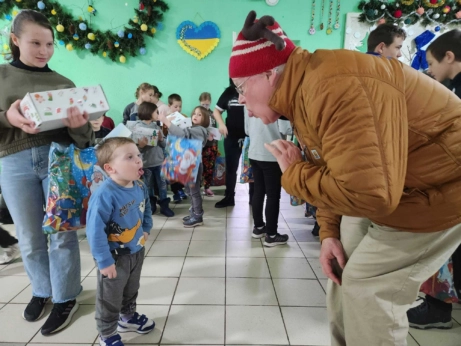How Does Food Get Delivered to Hungry People in Conflict Zones?
In the midst of war and conflict, access to food can quickly become precarious. Here’s how a few organizations and aid workers go about distributing food in the middle of war.
How Does Food Get Delivered to Hungry People in Conflict Zones?
In the midst of war and conflict, access to food can quickly become precarious. Here’s how a few organizations and aid workers go about distributing food in the middle of war.

Aid workers delivering food in Gaza. by World Central Kitchen
In 1948, it was a heady, idealistic time. Following World War II, many countries found themselves united in opposition to the hideous crimes they had just witnessed.
In the aftermath of the war, the Universal Declaration of Human Rights was accepted by members of the United Nations (U.N.) at the Palais de Chaillot in Paris. Among the resolutions in the foundational text is Article 25. It reads, in part: “Everyone has the right to a standard of living adequate for the health and well-being of himself and his family, including food, clothing, housing and medical care.”
The right to food seems so basic; in 1948, it seemed unimaginable that we would be where we are today, with 828 million people living in hunger, according to the latest numbers from the World Health Organization. Most of those people—more than 85 percent—live in areas affected by conflict and war.
In 2015, the U.N. targeted 2030 as the year it would end hunger and food insecurity. In the past decade, we’ve seen catastrophic wars and food crises in South Sudan, Syria, Yemen, Haiti, Gaza, Ukraine and Somalia topping the list, with tens of millions of their citizens suffering almost unimaginable hardship, hunger and suffering. The populations in those conflict zones risk starvation, because access to food has been either coincidentally or intentionally cut off.
While the U.N. unanimously passed a resolution condemning the use of food insecurity and starvation as a tactic of war in 2018, the resolution isn’t legally binding. The only way the millions of people in conflict zones are getting food that they don’t grow or find themselves is through the efforts of nongovernmental organizations (NGOs) and nonprofits, often staffed by volunteers who risk their lives to deliver food to people on the front lines.
The circumstances and details of delivery vary considerably.
“Logistics for delivery of aid differ depending on many factors, from the location, geography and weather to the nature of the disaster, beneficiaries, time of year and level of conflict,” says Christine Quinn Antal, co-founder of the nonprofit Task Force Antal and a veteran with years of experience operating in conflict zones and managing crises. Task Force Antal focuses on providing food, evacuation support and humanitarian aid with a team of elite special operations veterans in conflict zones across the world. “Keeping supply chains safe and secure is always a major focus, so we can maintain confidence that the food and supplies we’re delivering make it to the intended location without any tampering.”

Delivering aid in Somalia
For decades, Somalia has been enduring conflict and extreme drought. While the country’s Civil War was sparked in 1991 when Siad Barre’s military junta was overthrown, it has since devolved to include multiple warring rebel groups. Currently, more than four million people there are acutely food insecure and 1.7 million children aged five and under are expected to suffer acute malnutrition this year, according to CARE International.
CARE works in 97 countries, in a mission to promote social justice and defeat poverty. Justus Liku, the Kenya-based senior director of Humanitarian Response and Impact, explains that delivering food aid is one measure CARE takes to assist those in need.
“The drought in Somalia has killed tens of thousands of people and decimated crops and livestock that people depend on for their lives and livelihoods,” says Liku. CARE relies on food imported from nearby Kenya and Ethiopia and imports corn from Western Europe.
It also relies on imported nutritional supplements that malnourished children and parents need, as there is no supplement industry local to Somalia. “Getting food aid to people is very challenging in Somalia because there are so many conflicts, so crossing from one zone to another requires a great deal of planning and coordination.”
To conquer the logistics of delivering food by truck from one conflict zone to another within Somalia, CARE relies on a chain of local connections who meet each other near border crossings and deliver food from one truck to the other.
“The drivers know each other, and remain in contact,” says Liku. “It is complicated, but [it’s] the best way we have found to get food to people across Somalia.”
Thankfully, says Liku, mobile phone service is much more dependable in Somalia than in other countries in which CARE works, which enables delivery drivers to utilize GPS when necessary and communicate with each other and the people they’re trying to reach.
Finding local on-the-ground contacts is key to the NGO Human Appeal’s approach in Somalia, as well as its other efforts in 27 countries, including Sudan, Pakistan, Yemen and Iraq. In 2023, Human Appeal delivered food and nutritional support to 773,426 people. Each delivery, by design, was different.
“Local partners know the context and local challenges, and identify duly vetted local implementing partners,” says Owais Khan, deputy CEO of Human Appeal, a nonprofit organization working across the world to deliver aid and fight poverty and injustice. In an email, Khan told Modern Farmer that the group has an established model to assess the ability and capacity of local partners to help with food delivery projects. “The same applies to suppliers who need to be screened, have a solid track record and economically viable prices.”
Understanding each country’s needs, the demographics of the target group, the local diet and preferences and any other specific requirements such as religious or other food codes is essential, says Khan —and frequently, locals are the only ones who can truly decipher these often unwritten rules for outsiders.
The U.N.’s Humanitarian Response Plan in Somalia is woefully underfunded, with about 9.8 percent of the $1.59 billion needed funded this year.
“There are so many countries and people in need,” says Liku “and not enough funding.”

Delivering aid in Gaza
Food security experts warn that the war between Israel and Hamas has caused a food crisis that threatens every single person living in Gaza. Currently, about half of the population—1.1 million people—are facing severe hunger and the possibility of famine, according to Integrated Food Security Phase Classification, an agency that monitors global hunger. Delivering food has been a dangerous endeavor recently, when at least 112 Palestinians were killed and hundreds more wounded amid an aid truck delivery in Gaza.
World Central Kitchen (WCK), a nonprofit founded in 2010 by Chef José Andrés, has delivered more than 350 million meals around the world. WCK delivered food to Israelis after the October 7 attack that sparked the country’s war with Hamas and now is delivering food to Gaza.
In early March, WCK began exploring routes into Gaza, eventually partnering with the NGO Open Arms in securing a maritime route through Cyprus. The mission has been dubbed Operation Safeena, which translates to Operation Boat or Vessel in Arabic.
WCK has come under fire recently following allegations of sexual harassment within the top levels of the organization; however, that does not seem to have hampered its aid work. A spokesperson for World Central Kitchen said that WCK continues “to prepare about 300 tons of humanitarian food aid for a second sailing to Gaza from the Larnaca, Cyprus port.”
WCK is focused on delivering culturally appropriate, shelf-stable foods, such as beans, carrots, canned tuna, chickpeas, canned corn, parboiled rice, flour, oil and salt. To date, WCK has delivered 39 million meals by land, sea and air to Palestinians. More than 1,500 trucks have been dispatched for on-the-ground deliveries across Gaza from WCK’s Cairo warehouses, and more than 60 community kitchens have been opened in Gaza. During the sacred month of Ramadan, WCK is delivering daily airdrops, the spokesperson said.

Delivering aid in Ukraine
The war between Russia and Ukraine began in 2014 when the republic of Crimea was invaded by Russian troops in disguise. On February 24, 2022, Russia launched a full-scale invasion. Today, an estimated 3.7 million people are displaced in Ukraine, and 14.6 million people require humanitarian assistance, including food.
Children are especially vulnerable, says Susan Mathison, who co-founded Common Man for Ukraine in 2022 with Steve Rand, Lisa Mure and Alex Ray.
“When we visited Ukraine to see what we could do, we decided to focus on children, because we came to understand the enormity of what they were facing,” says Mathison. “Hundreds of thousands of children have been sent on trains from Eastern to Western Ukraine by their mothers who hope to keep them safe. Informal safehouses have sprung up to care for 2.5 million children.”
Two of the founding members of Common Man are members of the Plymouth Rotary Club in New Hampshire, and they used that connection to launch their mission.
“We knew we’d have to embed with local organizations on the ground if we wanted to succeed,” says Mathison. “So we called the Rotary presidents in Poland and Ukraine, and from there built an incredible network and system of delivery.”
Thus far, they have delivered more than three million meals to hungry children in more than 100 safehouses across Ukraine, using trucks driven by around 200 volunteers. They deliver locally produced traditional foods such as groat (similar to muesli or granola), canned meat and fresh produce grown by local producers, often to houses in the dead of night, and not necessarily with electricity.
“Sometimes, I feel like we’re not doing enough,” says Mathison. “How are we really helping if we can only serve a fraction of the people in need? But I’ve been there to see the looks on the faces of the children when they receive the food, and that’s when I realize that what we are doing does matter, because every child matters.”
Hope for Ukraine, a non-profit launched in 2016 by Ukraine native Yuriy Boyechko, has raised more than $8.4 million since the full-scale invasion began and operates under a similar model.
“We realized that millions would need our help,” says Boyechko. “We began organizing food and field kitchens and figured out how to deliver meal kits that would feed families of four for (over a week).”
Currently, Hope for Ukraine is supplying 1,500 families with meal kits every week, with the help of co-partners on the ground and more than 100 volunteer groups, which deliver food to the most hard-hit regions in frontline towns. The non-perishable food they deliver is largely locally sourced, with the goal of boosting the economy, and providing the kinds of food locals are used to.
“For a lot of people, this is their only lifeline,” says Boyechko. “Their infrastructure has been destroyed, and without this they will have no food. We are also operating five field kitchens with other pop-ups when possible and as needed.”
Currently, an estimated 10 percent of Ukraine’s humanitarian needs are being met, and Mathison says that donations have fallen off precipitously since the October 7 attack in Israel and the ensuing war there.
“There are so many problems happening in the world, it’s easy to stay frozen,” says Mathison. “But if we could all just focus on one country, or one child, or one project, the world will be a better place. Pick something that will make your heart sing.”

Want to donate to an NGO or food charity? Here’s what you should consider:
To ensure the safety of staff and success of the mission, always look at how the NGO interacts with and incorporates local groups into their work.
“At the end of the day, any organization you support should be working with the actual citizens and organizations based there,” says Antal. “They are critical to know how to get in and get out, especially in armed conflicts.”
To ensure your funds are actually going to help, ensure that the charity is legally registered and abides by the rules and regulations of its governing body. Also important is that it submits an annual report of its expenses, so you can see exactly where the money is going.
“A charity with a sustained track record of delivering aid to where it is needed most and regularly reporting its work to its donors is also key,” says Khan. “A professionally managed charity will always have internal policies and procedures that are applied across all internal functions to ensure proper governance and standards.”
In addition to the NGO’s featured above, here are vetted and widely respected organizations which you can feel safe donating money to:
The World Food Programme: Founded in 1963, it is the lead U.N. agency that responds to food emergencies and combats hunger worldwide.
Oxfam America: A global organization founded in 1942 fighting to end poverty and injustice.
Action Against Hunger: A global humanitarian organization that takes action against the causes and effects of hunger.
Follow us
This work is licensed under a Creative Commons Attribution-NoDerivatives 4.0 International License.
Want to republish a Modern Farmer story?
We are happy for Modern Farmer stories to be shared, and encourage you to republish our articles for your audience. When doing so, we ask that you follow these guidelines:
Please credit us and our writers
For the author byline, please use “Author Name, Modern Farmer.” At the top of our stories, if on the web, please include this text and link: “This story was originally published by Modern Farmer.”
Please make sure to include a link back to either our home page or the article URL.
At the bottom of the story, please include the following text:
“Modern Farmer is a nonprofit initiative dedicated to raising awareness and catalyzing action at the intersection of food, agriculture, and society. Read more at <link>Modern Farmer</link>.”
Use our widget
We’d like to be able to track our stories, so we ask that if you republish our content, you do so using our widget (located on the left hand side of the article). The HTML code has a built-in tracker that tells us the data and domain where the story was published, as well as view counts.
Check the image requirements
It’s your responsibility to confirm you're licensed to republish images in our articles. Some images, such as those from commercial providers, don't allow their images to be republished without permission or payment. Copyright terms are generally listed in the image caption and attribution. You are welcome to omit our images or substitute with your own. Charts and interactive graphics follow the same rules.
Don’t change too much. Or, ask us first.
Articles must be republished in their entirety. It’s okay to change references to time (“today” to “yesterday”) or location (“Iowa City, IA” to “here”). But please keep everything else the same.
If you feel strongly that a more material edit needs to be made, get in touch with us at [email protected]. We’re happy to discuss it with the original author, but we must have prior approval for changes before publication.
Special cases
Extracts. You may run the first few lines or paragraphs of the article and then say: “Read the full article at Modern Farmer” with a link back to the original article.
Quotes. You may quote authors provided you include a link back to the article URL.
Translations. These require writer approval. To inquire about translation of a Modern Farmer article, contact us at [email protected]
Signed consent / copyright release forms. These are not required, provided you are following these guidelines.
Print. Articles can be republished in print under these same rules, with the exception that you do not need to include the links.
Tag us
When sharing the story on social media, please tag us using the following: - Twitter (@ModFarm) - Facebook (@ModernFarmerMedia) - Instagram (@modfarm)
Use our content respectfully
Modern Farmer is a nonprofit and as such we share our content for free and in good faith in order to reach new audiences. Respectfully,
No selling ads against our stories. It’s okay to put our stories on pages with ads.
Don’t republish our material wholesale, or automatically; you need to select stories to be republished individually.
You have no rights to sell, license, syndicate, or otherwise represent yourself as the authorized owner of our material to any third parties. This means that you cannot actively publish or submit our work for syndication to third party platforms or apps like Apple News or Google News. We understand that publishers cannot fully control when certain third parties automatically summarize or crawl content from publishers’ own sites.
Keep in touch
We want to hear from you if you love Modern Farmer content, have a collaboration idea, or anything else to share. As a nonprofit outlet, we work in service of our community and are always open to comments, feedback, and ideas. Contact us at [email protected].by Kathleen Willcox, Modern Farmer
March 26, 2024
Modern Farmer Weekly
Solutions Hub
Innovations, ideas and inspiration. Actionable solutions for a resilient food system.
ExploreExplore other topics
Share With Us
We want to hear from Modern Farmer readers who have thoughtful commentary, actionable solutions, or helpful ideas to share.
SubmitNecessary cookies are absolutely essential for the website to function properly. This category only includes cookies that ensures basic functionalities and security features of the website. These cookies do not store any personal information.
Any cookies that may not be particularly necessary for the website to function and are used specifically to collect user personal data via analytics, ads, other embedded contents are termed as non-necessary cookies.
Your reporting regarding the delivery of supplies to Gaza faila to recognize that enough food has been delivered to sustain twice the population for the time since October 7. The question is where did it go and who is reselling it on the open market at 20+ times the pre-October cost. Getting it in has not been an issue despite the reports. It is where it goes. That is being ignored in this article.